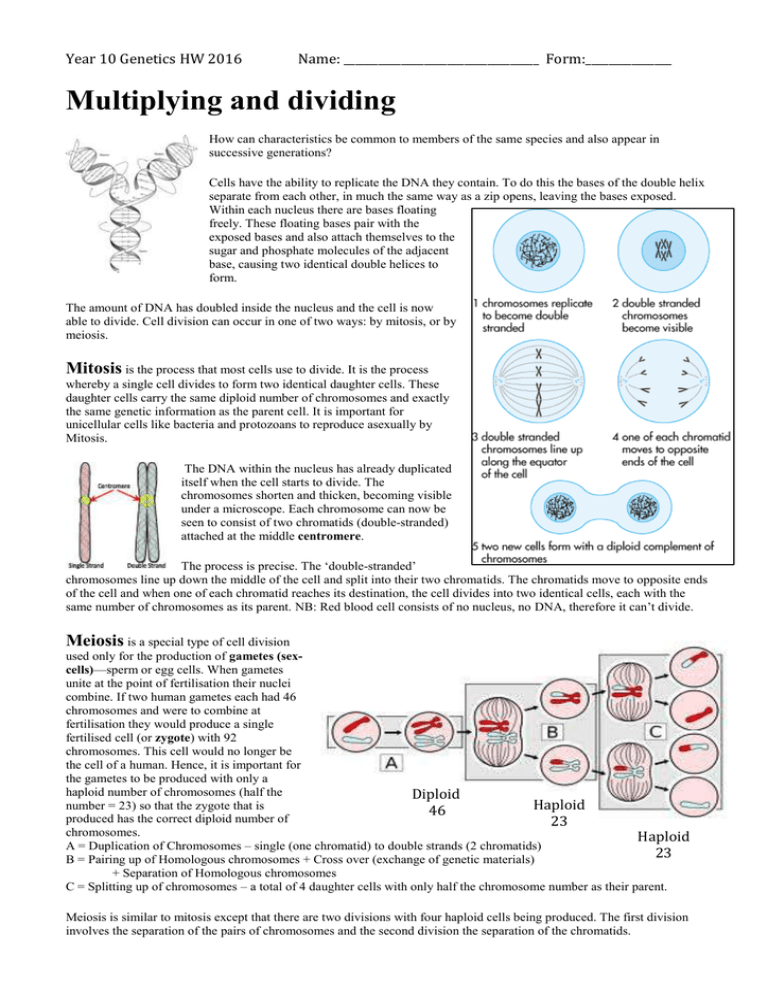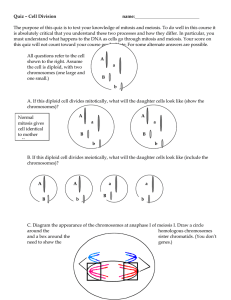Mitosis and Meiosis
advertisement

Year 10 Genetics HW 2016 Name: __________________________________ Form:_______________ Multiplying and dividing How can characteristics be common to members of the same species and also appear in successive generations? Cells have the ability to replicate the DNA they contain. To do this the bases of the double helix separate from each other, in much the same way as a zip opens, leaving the bases exposed. Within each nucleus there are bases floating freely. These floating bases pair with the exposed bases and also attach themselves to the sugar and phosphate molecules of the adjacent base, causing two identical double helices to form. The amount of DNA has doubled inside the nucleus and the cell is now able to divide. Cell division can occur in one of two ways: by mitosis, or by meiosis. Mitosis is the process that most cells use to divide. It is the process whereby a single cell divides to form two identical daughter cells. These daughter cells carry the same diploid number of chromosomes and exactly the same genetic information as the parent cell. It is important for unicellular cells like bacteria and protozoans to reproduce asexually by Mitosis. The DNA within the nucleus has already duplicated itself when the cell starts to divide. The chromosomes shorten and thicken, becoming visible under a microscope. Each chromosome can now be seen to consist of two chromatids (double-stranded) attached at the middle centromere. The process is precise. The ‘double-stranded’ chromosomes line up down the middle of the cell and split into their two chromatids. The chromatids move to opposite ends of the cell and when one of each chromatid reaches its destination, the cell divides into two identical cells, each with the same number of chromosomes as its parent. NB: Red blood cell consists of no nucleus, no DNA, therefore it can’t divide. Meiosis is a special type of cell division used only for the production of gametes (sexcells)—sperm or egg cells. When gametes unite at the point of fertilisation their nuclei combine. If two human gametes each had 46 chromosomes and were to combine at fertilisation they would produce a single fertilised cell (or zygote) with 92 chromosomes. This cell would no longer be the cell of a human. Hence, it is important for the gametes to be produced with only a haploid number of chromosomes (half the Diploid number = 23) so that the zygote that is Haploid 46 produced has the correct diploid number of 23 chromosomes. Haploid A = Duplication of Chromosomes – single (one chromatid) to double strands (2 chromatids) 23 B = Pairing up of Homologous chromosomes + Cross over (exchange of genetic materials) + Separation of Homologous chromosomes C = Splitting up of chromosomes – a total of 4 daughter cells with only half the chromosome number as their parent. Meiosis is similar to mitosis except that there are two divisions with four haploid cells being produced. The first division involves the separation of the pairs of chromosomes and the second division the separation of the chromatids. Year 10 Genetics Homework - Mitosis and Meiosis Name: ___________________________ Using the information provided to answer the following questions: 1. What actually makes the cell division possible in living things? (Hint: the structures and chemicals found inside the nucleus) 2. Why does a DNA molecule have a double helix structure? 3. What is Mitosis? 4. What is the meaning of “Diploid number” of chromosomes? What is the number in a normal human cell? 5. Name the structure that holds the duplicated chromosomes together. Draw a simple diagram to show the replication of a chromosome from one strand to double strands and the splitting up of chromosomes. Label the diagram. 6. Give 2 uses of Mitosis. 7. What is the purpose of the cell division by Meiosis? 8. What are gametes? What do you call the gametes in male and the gametes in females? 9. What is the meaning of “fertilisation”? (Don’t answer like: make baby) 10. Why is it important to reduce the chromosomes to half (from diploid 46 to haploid 23) in the formation of sperms and eggs? 11. How many chromosomes are found in: a) a sperm = b) an unfertilised egg = c) a fertilised egg (zygote) = d) a red blood cell with no nucleus = 12. Give 3 differences between mitosis and meiosis – using a table Mitosis Where it occurs No of daughter cells formed (2 or 4) The number of chromosomes in daughter cells (diploid = 46 or haploid = 23) Genetic variation of daughter cells (yes or no) Pairing up and separation of homologous chromosomes (yes or no) 13. What is the advantage of meiosis over mitosis as the method to reproduce? Meiosis







